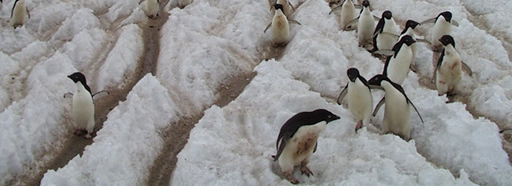Antarctic Penguin Research
Dr. Emslie's research in Antarctica focus on both living penguins and with abandoned penguin colonies or places where birds used to gather on land to breed. These abandoned sites contain a wealth of information on the species that used to breed there as well as what they ate. Organic remains are well preserved in the sediments at these sites due to the cold climate. By excavating into the sediments, Dr. Emslie and his team find bones of penguins plus remains of the food they ate (fish bones and other remains). They will also find bones and feathers from penguin chicks that died on the colony sometime in the past. They do not know why they died, but on modern colonies some birds usually die from disease, starvation, or predation. Their bones that are left behind, however, can be identified and tell researchers which penguin species once occupied the site.
The penguin colonies that Dr. Emslie and his students study are currently or were formerly occupied by Adelie (picture), Chinstrap (picture), or Gentoo (picture) penguins, three of the more common species found in the Antarctic Peninsula.
Once the researchers know what species used the colony in the past, careful sifting of the sediments provides many small bones and parts of fish and squid. Although these penguins eat lots of krill, a shrimp-like crustacean, they also eat fish and squid. The fish ear bones, or otoliths, preserve well in the sediments and can be identified to species. In addition, squid have a hard mouth part that looks like a small bird beak. These squid "beaks" also preserve well and can be identified to species. In excavating these abandoned colonies, we find hundreds of fish bones, otoliths, and squid beaks that tell us what the penguins were eating in the past.
How old are the sites? Dr. Emslie and his team can take some of the penguin bones and have them dated using radiocarbon analysis. It tells us the age of the bones, or how long ago the bird died, with an accuracy of within 40-50 years. When we date several of these bones from one colony, they can get an approximate time as to when the colony was occupied and abandoned.
Did climate change play a role in why the colony was abandoned? This is one of the primary questions Dr. Emslie is trying to answer. To do so, he must look at when the colony was occupied and what the climate was like at that time. He already knows what the climate was like in Antarctica in the past from studies of ice cores in glaciers. By drilling into the ice, scientists learn about past temperatures. Tiny air bubbles trapped in the ice when it formed hundreds or thousands of years ago can be analyzed for the chemical composition of the ancient air. These chemicals tell us if the climate was warmer or cooler in the past compared to today. It is quite an accurate technique and he can use the information to compare with when the abandoned colonies were occupied. So far, he has found that some colonies were occupied during warmer periods in the past by Chinstrap penguins, but Adelie penguins occupied more sites during colder periods.



